
# 2719 - 1992 29c Contemporary Christmas: Locomotive, self-adhesive
1992 29¢ Locomotive
Contemporary Christmas
City: New York, NY
Quantity: 21,600,000
First USPS ATM Stamp
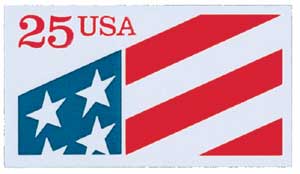
On May 18, 1990, the USPS issued an experimental plastic stamp to test the popularity of selling stamps through Automatic Teller Machines (ATMs). While the plastic stamp proved unpopular, especially with environmentalists, the ATM format proved to be a success.
While this was a first for the USPS, two years earlier a private company tested a similar idea. On December 14, 1988, Pittsburgh, Pennsylvania’s Equibank ABMs dispensed regular US coil stamps under a system they called The Stamp Shop. The stamps were sold in groups of nine, affixed to carrier paper that was in the same size and shape of a dollar bill.

The USPS ATM stamp was born out of the development of pressure-sensitive stamps in 1986. They weren’t specifically thinking about ATMs at the time – that development came in November 1987. At that time, they began working on a vending machine program and workers found themselves constantly thinking about the different things offered by vending machines. Then in March 1988, someone said in passing that “One of these days it might be possible to make stamps that ATMs could dispense like currency.” The new postmaster general, Anthony Frank, had come from the banking industry and was immediately intrigued. He told his team to see if they could do it.
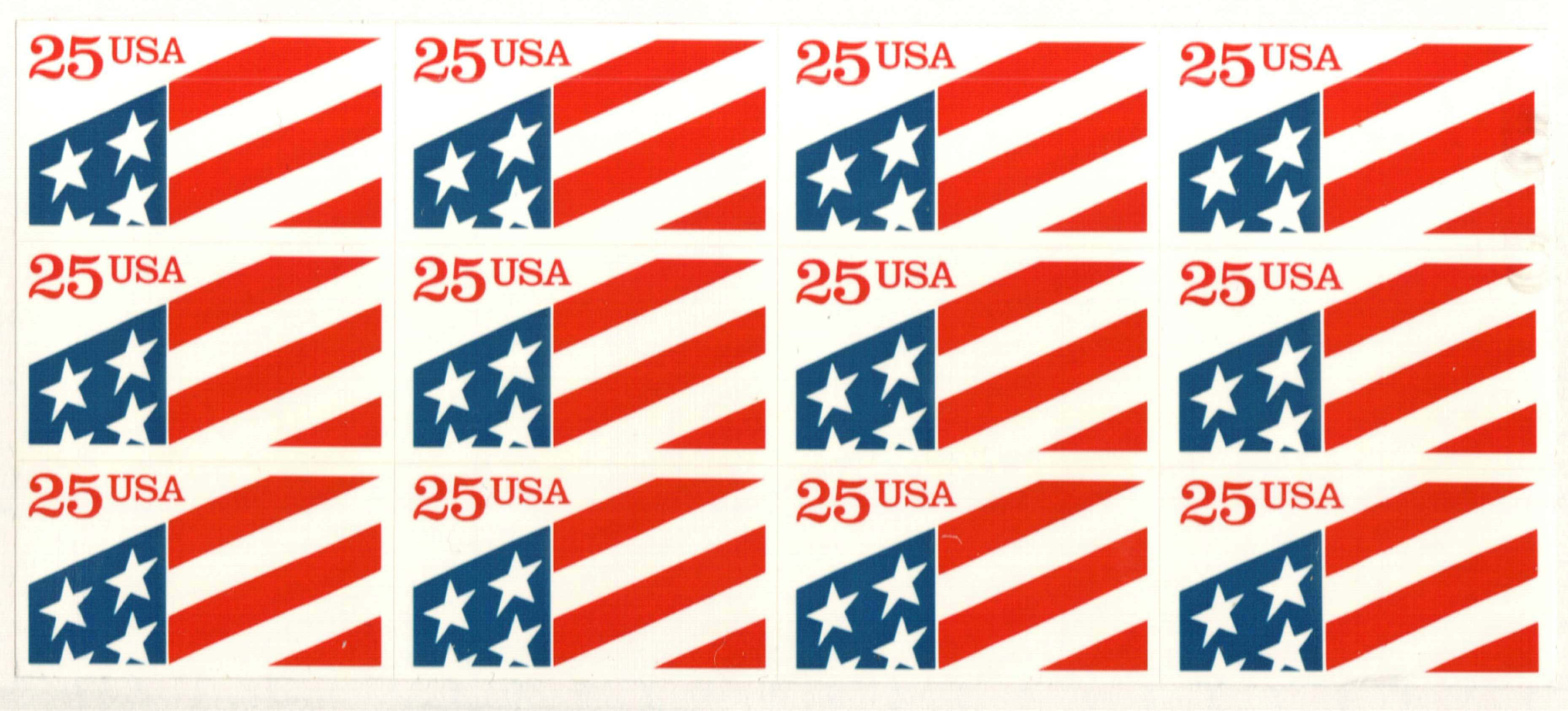
Partnering with Seattle First National Bank (Seafirst), the Postal Service’s Stamp and Engineering Divisions joined forces to develop a stamp sheet that could be dispensed from ATMs. Because the machines depended on the exact thickness of currency (to prevent “double-vending”), the new ATM stamps had to be exactly the same shape and thickness as US paper currency.
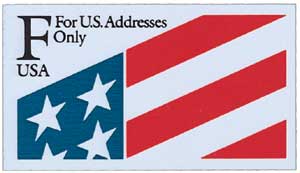
To achieve this, the USPS first tried a stamp made of conventional paper. They found that unlike currency paper, stamp paper would not allow the precise depth control needed for ATM use. The idea of using plastic came from pharmaceutical labels. Plastic proved to be a good product as far as depth control was concerned, and plastic took gravure printing extremely well. The USPS proceeded with a plastic, die-cut, imperforate sheet of 12 stamps, attached to a self-adhesive backing, in the exact shape of paper currency.

The USPS displayed specimens of the new stamps at World Stamp Expo in late 1989. They brought an ATM into the convention center to show how the stamps would be vended. The stamps were also included in a video presentation on the “Post Office of the Future.” In announcing the stamps, the postmaster general said that postal customers would have “round-the-clock access to stamps.” And that “For years, customers have enjoyed the convenience of ‘banking by mail.’ Now they will have the convenience of ‘mailing by bank.’”
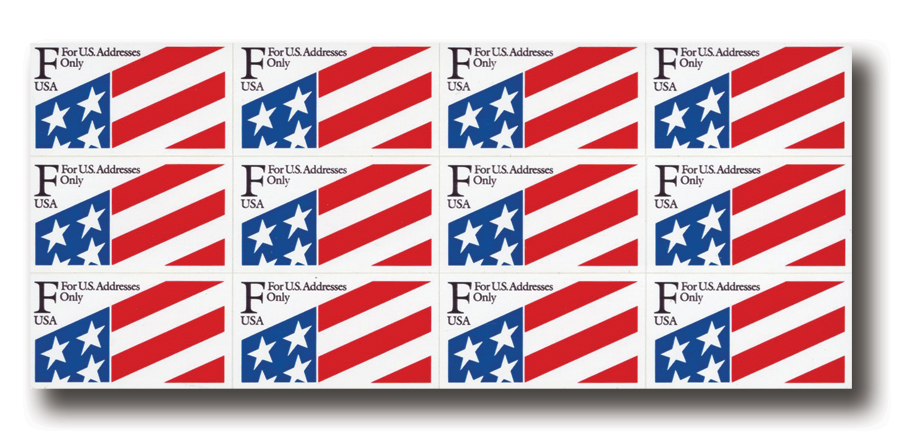
Under this plan, cardholders could select the stamps from a menu of banking options. The cost of the stamps would be deducted from their account and the stamps would be dispensed just like money. Customers would also receive a bank receipt showing the date, location, and transaction account. Some collectors would keep their receipts in their albums alongside the stamps.
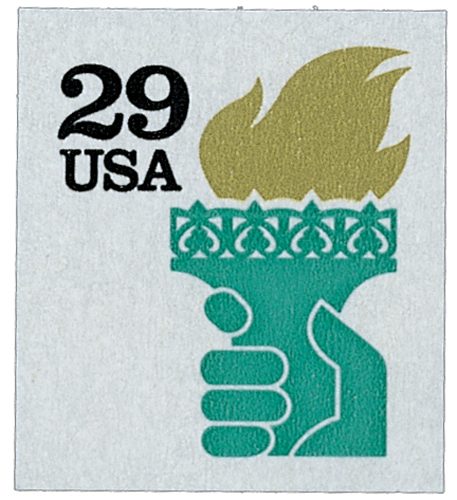
The first plastic flag stamps were issued at five ATMs on May 18, 1990, at the Seattle Columbia Seafirst Center during the stamp’s First Day Ceremony. The following day, the ATM stamps were also sold at another 22 ATMS in 10 Seattle locations. Although born of a good idea – to offer 24-hour service to postal customers – the stamps were not without their critics. Environmentalists were against them because they were made of plastic, and recyclers warned they would make paper envelopes useless for recycling. The USPS said that if the test proved successful, they would find ways to make future ATM stamps recyclable.
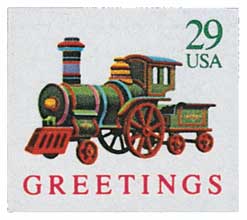
By the following year, the first class rate was changing, and the ATM experiment was still on-going. The USPS would have liked to have developed the recyclable paper stamps, but hadn’t quite done it yet. So, on January 22, 1991, they issued an “F” rate non-denominated stamp to meet ATM customers’ needs.
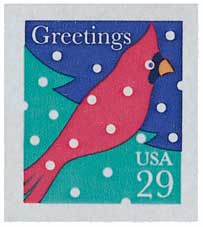
1992 29¢ Locomotive
Contemporary Christmas
City: New York, NY
Quantity: 21,600,000
First USPS ATM Stamp

On May 18, 1990, the USPS issued an experimental plastic stamp to test the popularity of selling stamps through Automatic Teller Machines (ATMs). While the plastic stamp proved unpopular, especially with environmentalists, the ATM format proved to be a success.
While this was a first for the USPS, two years earlier a private company tested a similar idea. On December 14, 1988, Pittsburgh, Pennsylvania’s Equibank ABMs dispensed regular US coil stamps under a system they called The Stamp Shop. The stamps were sold in groups of nine, affixed to carrier paper that was in the same size and shape of a dollar bill.

The USPS ATM stamp was born out of the development of pressure-sensitive stamps in 1986. They weren’t specifically thinking about ATMs at the time – that development came in November 1987. At that time, they began working on a vending machine program and workers found themselves constantly thinking about the different things offered by vending machines. Then in March 1988, someone said in passing that “One of these days it might be possible to make stamps that ATMs could dispense like currency.” The new postmaster general, Anthony Frank, had come from the banking industry and was immediately intrigued. He told his team to see if they could do it.

Partnering with Seattle First National Bank (Seafirst), the Postal Service’s Stamp and Engineering Divisions joined forces to develop a stamp sheet that could be dispensed from ATMs. Because the machines depended on the exact thickness of currency (to prevent “double-vending”), the new ATM stamps had to be exactly the same shape and thickness as US paper currency.

To achieve this, the USPS first tried a stamp made of conventional paper. They found that unlike currency paper, stamp paper would not allow the precise depth control needed for ATM use. The idea of using plastic came from pharmaceutical labels. Plastic proved to be a good product as far as depth control was concerned, and plastic took gravure printing extremely well. The USPS proceeded with a plastic, die-cut, imperforate sheet of 12 stamps, attached to a self-adhesive backing, in the exact shape of paper currency.

The USPS displayed specimens of the new stamps at World Stamp Expo in late 1989. They brought an ATM into the convention center to show how the stamps would be vended. The stamps were also included in a video presentation on the “Post Office of the Future.” In announcing the stamps, the postmaster general said that postal customers would have “round-the-clock access to stamps.” And that “For years, customers have enjoyed the convenience of ‘banking by mail.’ Now they will have the convenience of ‘mailing by bank.’”

Under this plan, cardholders could select the stamps from a menu of banking options. The cost of the stamps would be deducted from their account and the stamps would be dispensed just like money. Customers would also receive a bank receipt showing the date, location, and transaction account. Some collectors would keep their receipts in their albums alongside the stamps.

The first plastic flag stamps were issued at five ATMs on May 18, 1990, at the Seattle Columbia Seafirst Center during the stamp’s First Day Ceremony. The following day, the ATM stamps were also sold at another 22 ATMS in 10 Seattle locations. Although born of a good idea – to offer 24-hour service to postal customers – the stamps were not without their critics. Environmentalists were against them because they were made of plastic, and recyclers warned they would make paper envelopes useless for recycling. The USPS said that if the test proved successful, they would find ways to make future ATM stamps recyclable.

By the following year, the first class rate was changing, and the ATM experiment was still on-going. The USPS would have liked to have developed the recyclable paper stamps, but hadn’t quite done it yet. So, on January 22, 1991, they issued an “F” rate non-denominated stamp to meet ATM customers’ needs.










